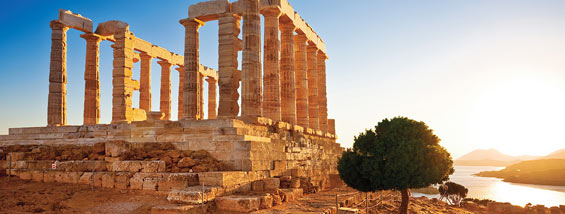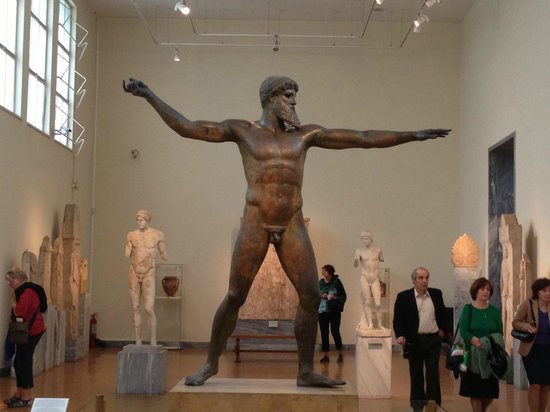Poseidon, the notorious Greek god of the sea (though he was also god of earthquakes, storms, and horses) has been held in high esteem over the millennia. The Romans recast him as the god Neptune, retaining his dominion over the sea. In Bologna, Italy, during the 16th century, the Fountain of Neptune was erected, becoming an iconic symbol of the city and remains so to this day.
However, us moderns might be most familiar with Poseidon through the Percy Jackson & the Olympians series by Rick Riordan, where Poseidon is cast as Percy Jackson’s father. There is also Maserati, the Italian luxury vehicle manufacturer, which sports Poseidon’s trident as their logo.
This is all just to list a number of ways that Poseidon has been and remains a cultural icon throughout the Western world. But what is it about this god that makes him so attractive, both in the ancient world and today?
Mythological Origins
Poseidon was the son of Kronos and Rhea, and, like the rest of his older siblings, was swallowed by his father until Zeus rescued them all. Once released, Poseidon joined his brothers and sisters in overthrowing their parents’ generation of gods in the Gigantomachy (the struggle between the gods and the giants).

Poseidon attacks Polybotes in the presence of Gaia, red-figure cup late fifth-century BC (Antikensammlung Berlin F2531)
With the Olympian gods now in control, Poseidon, Zeus, and Hades all drew lots to divvy up the realms of the world: Zeus got the sky and the heavens, Hades the underworld, and Poseidon took the seas.
Poseidon’s wife was the sea goddess Amphitrite, though, as is the case with Zeus, he bore children outside of his marriage, with human women and goddesses alike. His offspring included Triton, Polyphemus, Theseus, and Orion, to name a few.
The creation of the horse is most notably related to Poseidon. In a popular version of the myth, Poseidon is pursuing Demeter as she searches for Persephone, and in an effort to impress her, he creates the world’s most beautiful animal.
However, it took Poseidon so long to come up with the horse, that by the time he actually did, he had fallen out of love with Demeter. According to Pausanius though, while Demeter turned into a mare in order to escape Poseidon’s advances, in response he turned into a stallion and seduced her anyways.

Poseidon riding on a hippocamp (half winged horse, half sea serpent) alongside dolphins Clay, black-figure, ca. 500 BCE [Source: Mount Holyoke College Art Museum]
Poseidon as a god does not just rule the sea, but also horses, rivers, storms, floods, earthquakes, and has a hand in destruction in general. The most notable of his features is the trident, but other items such as a boulder, cloaks, headbands and celery wreaths, are attributed to him as well.
Poseidon’s palace was said to have been near Aegae in Euboea and would ride his golden mane horses and his chariot over the waves, while sea creatures steered out of the way at the sound and sight of his chariot.
In worship to Poseidon, Greeks would often sacrifice bulls, stallions, and male sheep. Interestingly enough, considering that Poseidon was seen as the cause of earthquakes, he was also revered as a protector against them. Since the Aegean is prone to many earthquakes, especially along the coast, many cities bore his name or erected temples dedicated to invoking Poseidon’s continued protection.
The Temple of Poseidon at Sounion is just one of many sanctuaries dedicated to Poseidon. Built in the mid-5th century BCE as part of the Periclean building program, it replaced an Archaic temple that had been razed by the Persians. The position of the temple served as a landmark for sailors rounding the bend into the Attica region, the last sign before approaching the harbors.
From the Iliad to Today
In the Iliad, Poseidon takes the side of the Greeks against the Trojans. He assists and restores the vigor of the Achaeans to fight and when Agamemnon considers setting sail to return home in defeat, Poseidon is the one who encourages him to continue the war.
Because the story takes place mostly on land, Poseidon’s power is portrayed mainly through earthquakes and is often referred to as the “Mighty Earthshaker.” In fact, there is one Poseidon-induced earthquake so terrible that Hades “shrieks in terror,”
Fearing the god who rocks the ground above his realm,
giant Poseidon, would burst the earth wide open now
and lay bare to mortal men and immortal gods at last
the houses of the dead…
In the Odyssey, Poseidon continues to play his role as Earthshaker. Yet here Poseidon’s wrath is directed at Odysseus, playing the role of his divine antagonist. Poseidon holds a grudge against Odysseus for blinding his son, the Cyclops Polyphemus. Due to this grudge, he goes out of his way throughout to make Odysseus’s return to Ithaca as difficult as possible.
In the realm of art, the Artemision Bronze is a famously debated sculpture recovered off of northern Euboea in 1926. The sculpture depicts a god, either Zeus or Poseidon. Since Zeus and Poseidon often appear in similar statures and stances, whatever object is about to be thrown, missing from the sculpture, would be the only defining characteristic of the sculpture.
The problem with the statue being a depiction of Poseidon is that a trident would have obscured the face of the god, while a lightning bolt would have been more fitting to the stance and arm placement. Still, mainly based on the fact that the statue is found by Artemision, whose protector was Poseidon, the statue remains ambiguously classified.
Today, Poseidon is used as an epithet for the power and ferocity of the sea. In the ancient world, he played an important role in both Greek and Roman mythos. The cults that arose out of this mythos erected temples in his honor and made sacrifices in his name. His presence in both the Iliad and the Odyssey, and the power he is attributed, serves as a reminder of how large Poseidon loomed in the minds of the ancient Greeks, and why he looms so large still.












No comments
Trackbacks
Our apologies, you must be logged in to post a comment.